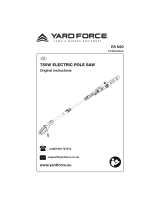
13
ENGLISH
◆ We recommend that you use only one brand
of oil during the lifetime of your chainsaw
because mixtures of different oils could lead to
the oil becoming degraded, which can
drastically shorten the lifetime of the saw chain.
◆ Never use waste oil, thick oil or very thin
sewing machine oil. These may damage your
chainsaw.
Fitting the guide bar and chain (fig. B & C)
Always wear protective gloves when
working on your chainsaw and ensure that
the plug is not in the electrical outlet.
◆ Fit the saw chain (9) over the guide bar (8),
making sure that the cutters are the right way
round and that the slider tensioner (11) is
facing towards you (fig. B).
◆ With the tool horizontal on a stable surface,
put the bar and chain onto the bar mounting
studs (13), ensuring the chain is around the
drive sprocket (12). Make sure that the cutters
on the upper part of the guide bar face
towards the front (fig. B).
◆ Before fitting the chain cover check that the
cam (18) is in the correct position.
If necessary, press and turn the control knob (7)
clockwise to rotate the cam into the correct
position.
◆ Fit the chain cover by locating the bolt and
using the control knob (7) to tighten the chain
cover finger tight. To tension the chain, loosen
the control knob one full turn, press in firmly
and rotate clockwise. As the bar moves
forward make sure that the chain links feed
into the guide bar. When the control knob
stops rotating apply further light pressure.
Do not over-tension. Allow the control knob to
spring back to the „out“ position and rotate
further clockwise to tighten the guide bar.
Apply moderate pressure to tighten.
◆ Check the chain tension. The tension is correct
when the chain snaps back after being pulled
3 mm away from the chain bar with light force
from the middle finger and thumb.
There should be no „sag“ between the guide
bar and chain on the underside.
Note: Do not over-tension the chain as this will
lead to excessive wear and will reduce the life of
the bar and chain.
Note: When the chain is new, check the tension
frequently (after disconnecting from the mains)
during the first 2 hours of use as a new chain
stretches slightly.
USE
Let the tool work at its own pace.
Do not overload.
Filling oil into the reservoir (fig. E)
◆ Remove the oil cap (3) and fill the reservoir with
the recommended chain oil. You can see the oil
level in the indicator slot (4). Refit the oil cap.
◆ Periodically switch off and check the oil in the
indicator; if it is less than a quarter full,
disconnect your chainsaw from the mains and
refill with the correct oil.
Auto-stop chainbrake (fig. F & G)
This tool is fitted with an auto-stop chainbrake which
will stop the chain within 150 ms each time you
release the rear trigger, or if kickback should occur.
This brake should be tested before every use.
How to set the chainbrake
◆ Make sure that the tool is disconnected from
the mains supply.
◆ Pull the front guard (5) back into the „set“
position .
The tool is now ready to use.
How the anti-kickback chainbrake works
In the event of kickback, your left hand comes in
contact with the front guard, pushing it backwards,
and stops the tool within 150 ms.
How the inertia activated chainbrake works
The chainbrake is activated when the front hand
guard is pushed forward, either manually, by the
back of the users hand or by its own weight. The
advantage of the inertia brake is that it is activated
by a severe kickback, eg. when the chain hits metal,
even if the users hand does not contact the front
guard, ie. when the saw is in the felling position.




















